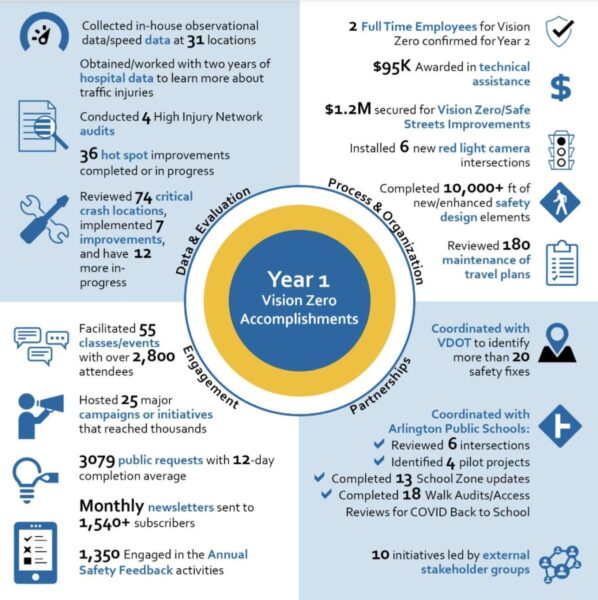
Four people died in crashes in Arlington during 2021, the first year of the county’s initiative to eliminate traffic fatalities and injuries.
That’s in addition to 61 severe crashes, according to the first annual report evaluating the transportation safety initiative Vision Zero.
Arlington County is measuring the effectiveness of its five-year action plan by tracking the severity of crashes and factors involved, such as speed, alcohol and whether a pedestrian or bicyclist were injured.
This month marks the kickoff of the initiative’s second year, which will feature awareness campaigns around behaviors that lead to serious crashes. The campaign will run through December and concentrate on different behaviors each month, starting with bike awareness.
The overall number of crashes in 2021 — 1,785 — decreased by about 30% compared to previous years, but that was attributable to lower traffic levels compared to pre-pandemic years, according to the report.
All four fatal crashes occurred at intersections, and did not involve a pedestrian or bicyclist. In 2020, there were four fatal crashes and 50 that caused severe injury, according to the county’s crash analysis dashboard.
The report noted the 174 alcohol-related and 487 speed-related crashes in 2021 marked a slight uptick. Speed was a factor in one of the fatal crashes.
Lessons learned
Many of the more than 90 action items the county lists in the framework have been checked off. Arlington has completed or started 36 small-scale safety projects, finished an analysis of 69 crash hot spots, and facilitated 55 transportation safety classes and events, among other tasks.

Some of the lessons learned in year one include a need to amp up community engagement, and decrease the frequency of crash hot spot analyses from once a year to every two years.
Two walkability routes that were piloted saw opposite outcomes. A pilot on Lorcom Lane in residential North Arlington was extended and county staff are looking to fund a permanent sidewalk there in the upcoming Capital Improvement Plan.
The report noted the Lorcom Lane path “showed high usage, positive community feedback, and observed benefits from separating cars, bikes, and pedestrians.”
But the county halted a similar effort — temporary bollards and wheel stops on S. Carlin Springs Road — months after placement. Arlington Public Schools, Arlington police and community members raised concerns with the pilot after observing “erratic driving around the barriers.”
That area of S. Carlin Springs Road has narrow sidewalks, little or no pedestrian buffer and a history of crashes. The goal of the pilot was to create a safer walking path for students at Campbell Elementary School, Carlin Springs Elementary School and Kenmore Middle School.
County staff will continue to assess options for “enhancing sidewalks and access along the corridor, including connectivity options when the County redevelops the Virginia Hospital Center site,” according to the report.
Several other efforts to increase safety, particularly around schools, advanced in the first year of Vision Zero. The installation of 20 mph school slow zones around 13 schools in early 2022 is under evaluation and could be extended to all schools in the county.
In January, the County Board approved speed cameras in school and work zones, heralding them as a step toward the Vision Zero goal.
In the upcoming year, the report says, there are two full-time employees confirmed to work on Vision Zero and some studies will be completed, such as the evaluation of roadways that have speed limits above 30 mph.

